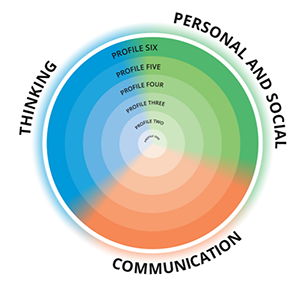In the heart of every elementary classroom in British Columbia there is change happening that is reshaping the way we teach, learn, and understand mathematics. The days of rote memorization and endless worksheets are gone. In their place is a dynamic, competency-driven approach that empowers students not only to “do math,” but to think mathematically, communicate effectively, and solve real-world problems.
As educators, we’re navigating a landscape shaped by BC’s Core Competencies, fueled by digital platforms and social media, and energized by frameworks like project-based learning and the Open Hub Model. Yet, within this evolution lies an ongoing tension: how do we balance the cognitive demands of learning with the creative freedom of inquiry?
The Core Competencies: Building a Foundation for Lifelong Mathematical Thinking
BC’s redesigned curriculum places the Core Competencies (Communication, Thinking, and Personal and Social) at the center of all learning. In the math classroom, these competencies are more than buzzwords; they are the bedrock of how students engage with content.
- Communication means students articulate their reasoning, ask thoughtful questions, and explain strategies to peers.
- Thinking covers both critical and creative thinking, allowing students to flexibly approach mathematical challenges, evaluate outcomes, and seek new patterns.
- Personal and Social awareness emerges when students collaborate, persevere through tough problems, and reflect on their growth.
Rather than seeing math as isolated from these competencies, we see that mathematical understanding emerges through them. A student who explains how they approached a fractions problem is developing both numeracy and communication. One who tries a new approach to a patterning question is exercising creative thinking.

Math as a Living, Breathing Center
One framework gaining traction in BC is the Open Hub Model, which positions math as a central “hub” with open spokes connecting it to other disciplines, real-world issues, and student interests.
In this model, the math classroom becomes:
- A collaborative space where ideas are exchanged freely,
- A cross-curricular space connecting science, art, and even social studies through data, patterns, and problem-solving,
- A student-led zone where inquiry and exploration are supported by real-world applications.
For example, a unit on measurement might spiral outward to include:
- Science (measuring plant growth),
- Art (proportional drawing),
- Social studies (examining scale in maps), and
- Language arts (writing reflections on the process).
This model aligns beautifully with the Core Competencies, It also helps to break down walls that too often separate math from other areas of learning.
Connecting Classrooms, Ideas, and Educators
The Open Hub Model and competency-based learning also thrive when educators are connected—and today, those connections often happen online.
Platforms like Instagram, and Threads are full of BC educators sharing resources, insights, and real student work.
Benefits of integrating social media into your professional practice include:
- Showcasing student work (with appropriate permissions),
- Learning from others who are innovating in their classrooms,
- Finding ready-to-use resources, ideas for math provocations, or rich tasks,
- Connecting with thought leaders and staying informed on current research.
What Does Success Really Mean in Elementary Math?
It’s tempting to define success in math by test scores or the ability to compute quickly. But when we teach with the Core Competencies in mind, our definition of success must evolve.
In BC’s classrooms, success might look like:
- A student re-attempting a challenging problem after learning from a mistake,
- A group developing multiple ways to represent a solution—graphically, numerically, and verbally,
- A child discovering joy in patterns and symmetry while designing a quilt square,
- A reluctant learner finally feeling confident enough to share their thinking with peers.
These are successes of process, not just outcome. They reflect a deeper kind of mathematical understanding—one that values reasoning, collaboration, and persistence over speed and memorization.
Project-Based Learning: Deepening Math Through Context
Project-Based Learning (PBL) invites students to tackle real, complex problems that require sustained inquiry and interdisciplinary thinking. In math, this might include:
- Designing a school garden using area and perimeter,
- Planning a community fundraiser and managing a budget,
- Conducting a survey and analyzing data,
- Building 3D models and calculating volume for a “dream home.”
The beauty of PBL in math lies in its authenticity. Students aren’t just solving contrived problems, they’re applying math to the real world, engaging multiple Core Competencies, and often working collaboratively over days or weeks. It allows for more student buy in and attention to the task at hand.
PBL also invites voice and choice. Students who might not shine on a timed test can take ownership of a meaningful project, showcase their strengths, and develop confidence in their math identity.
A Productive Tension
This is where the conversation gets nuanced.
Cognitive Load Theory (CLT), rooted in educational psychology, warns us that working memory has limits. If students are overwhelmed with too much new information at once, or too much ambiguity, they may not learn effectively. CLT suggests that well-structured, explicit instruction helps reduce this “load” and supports foundational skill-building.
On the other hand, Inquiry-Based Learning (IBL) encourages students to explore, ask questions, and make discoveries. It values curiosity, engagement, and deep thinking—qualities we absolutely want to foster in math learners.
So how do we reconcile these?
We can use explicit instruction in a strategic way to build fluency and confidence with essential math skills (eg., multiplication strategies, understanding place value). Then use those skills to transition students into inquiry, allowing students to apply what they’ve learned in rich, open ended problems or projects.
This combination—sometimes called “guided inquiry”—respects the cognitive science behind learning while honoring the spirit of exploration that fuels deeper understanding.
It’s not an either/or. It’s a balance between structure and freedom, clarity and creativity.
Next Steps for BC Elementary Teachers
Start small is my advice.
Use student-friendly language to frame your math learning intentions.
Use one open-ended task a week. There is a good chance students haven’t had experience yet and need to feel safe exploring and reflecting.
Document student thinking any way you can. Take pictures, use post-it notes or math journals, and take the time to reflect with your class.
Join a professional learning network.
Work towards completing a mini math project. A great first PBL unit is designing a new school playground using math.
The Students are at the Center
In all of this, the Core Competencies, Open Hub Model, social media, PBL, and theoretical debates, the most important thing remains the same:
The students are at the center.
Not the textbook. Not the test. Not the lesson plan. The students.
BC’s evolving approach to math instruction is one that sees students not as empty vessels to be filled with formulas, but as thinkers, makers, and explorers. It acknowledges that a strong math education is not about ticking off outcomes but about developing capacities for reasoning, communicating, creating, and caring.
As we continue to refine our practice, build professional connections, and learn from one another, we’re collectively reimagining what math learning can be and how students get to feel successful in math.




Leave a Reply